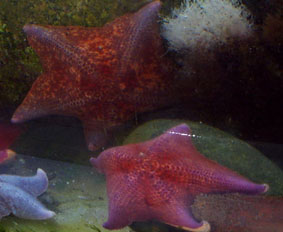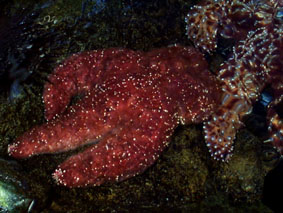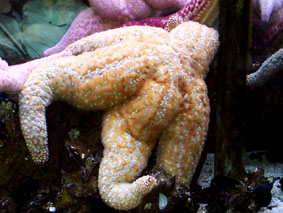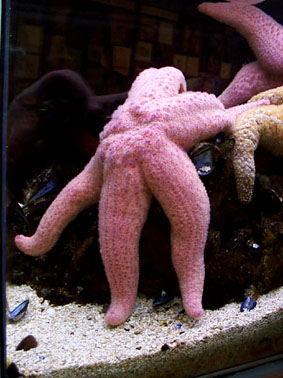
The Bat star is a sea star that belongs to the Order Spinulosida. The classification is outlined below:
The Subclass Asteroidea has three Order of which the Bat star belongs to the Spinulosida. Spinulosida are characterized by having aboral spines and tube feet with suckers which it uses in it's feeding mechanisms.
The Bat stars belong to the Family Asterinidae whose members are characterized by externally holding developing embryos below the oral surface among the spines. This enables them to carry the juveniles in a raised apical system. In Southern California, only one Genus is found within the Asterinidae, this is the Asterina. Since there is only one Genus in the Asterinidae, it's distinguishing features are the same as the Family characteristics.
Asterina miniata (Brandt, 1835). Common name - Bat or Webbed sea star. The Bat star was formerly called Paterina miniata. The bat star has varying coloration from pale orange to deep purple, and occasionally they are mottled with more than one color. The bat star is typically omnivorous feeding on a wide variety of plants and animals. Bat stars are common among rocks overgrown with surfgrass, larger algae, sponges, and bryozoans. It is also found in the low intertidal zone and the subtidal zone to 290 m. It is located from Sitka, Alaska, to Baja California, and Islas de Revillagigedo, Mexico.
Natural History of Southern California Sea Stars
Reproduction and Regeneration
Echinoderms have small eggs and their sperm have spherical heads. The larvae start life in bilaterally symmetrical form and the adults attain a radial symmetry around a center point. For almost all of the sea stars, spawning occurs generally between the months of March and April with the gonads enlarging during winter.
Asterina miniata spawn when exposed to air in the shade for one to four hours. Having transparent embryos and larvae that are easily reared.
The Pisaster ochraceus produce free-swimming, plankton feeding larva.
The Pisaster brevispinus will only mature if it is well fed other wise it will remain immature.
Echinoderms also have the ability to reproduce asexually, or regenerate. An Echinoderm can loose all but one of its legs, and then after a time, it can regenerate the others. Also, an Echinoderm can be cut in half and each half will grow a new half.
Habitats and location
Echinoderms can be found all along the coast of California and down into Mexico.
The Asterina miniata is found in the low intertidal zone among rocks overgrown with surf grass, or algae. The Asterina miniata may also found subtidaly on rock, shell, gravel, hard sand or algae.
Pisaster ochraceus can be found closer to Canada in the middle and low intertidal zone on wave-swept rocky shores.
Pisaster giganteus is found in low and subtidal regions. Mostly in protected coastal areas, occasionally found on sand, rocks and pier pilings.
Pisaster brevispinus is found from the rocky intertidal to the subtidal sand and mud bottoms.
Feeding
Most sea stars are active carnivores with a few exceptions, one being Asterina miniata which is an omnivore. Asterina miniata eats plants, algae and animals dead or alive; occasionally it will eat other sea stars.
Sea stars eat by extending their stomach. When eating Mytilus californicus, a favorite delicacy of the Pisaster genus, the sea star will grasp each side of the mussel and then contract the tube feet, trying to pull the two shells apart. The mussel eventually relaxes, or perhaps some of its hinge is digested away. The sea star can then insert it's stomach into a gap between the shells as small as 0.1 mm. Therefore the sea star has the ability to digest food outside it's body.
Many sea stars feed without actually swallowing their food. Food preferences (excluding Asterina miniata) include mussels (Mytilus californicus), snails (Nucella emargnata), chitons (Nuttallina fluxa), and barnacles (Balanus glandula).
Regulating Factors of population
There are two major factors that regulate populations of sea stars; humans and mother nature.
Mother mature throws out obstacles for the sea stars to overcome, such as natural predators of the sea star larvae. Heavy predation on larval stages by various snails and nudibranchs can impact population drastically. Also, there is the elemental aspect of mother mature. Extreme temperature changes and wind conditions can effect population as well as tidal influence.
The other and more drastic regulator of sea star populations is the human. The disturbance of collecting organisms by tourists, divers, and students has become such a problem that it has been outlawed except for research purposes, and then only by special permission. The resulting decrease of populations due to the human factor are reversible, but only through time and conservation.
Predation
The two major predators of sea stars are sea gulls and sea otters. The sea otter, most of the time, only eats part of a sea star before discarding it. Because of this, sea otter feeding grounds usually contain a large number of sea star amputees regenerating one or two limbs.
The sea gull generally preys on sea stars in mussel beds where they are exposed to open shores for part of the day.
Sea stars, in general, have hard time actually catching prey because of an avoidance response that occurs in several abalone, limpets and turban snails. The organisms move away when they are touched by a sea star, but they can detect some sea stars by scent, and are stimulated to move away. The actual touch of a tube foot of a sea star can activate a more animated escape response in some organisms, such as the snail Nassarius fossatus that will leap and twist violently when touched.
Other Stuff
Asterina miniata was formerly called Paterina miniata. The common name is bat star or webbed star. The bat star was formerly abundant in San Diego Mission Bay, but with the elimination of the Eelgrass species, the bat star is almost gone. The Eelgrass was eliminated through "improvements" to Mission Bay for tourism. The bat star is long lived in captivity with a life span of about thirty years.

Pisaster ochraceus is commonly called the ochre star. The ochre star is the most air tolerant of all the Pisaster species. The ochre star is also one of the only sea stars that feeds all year round. An interesting observation of the ochre star is that when it is left undisturbed, and underwater, most of the body between the spines is covered with very small filaments giving the star a velvety appearance. These filaments are actually extrusions of the lining of the body cavity protruding through holes between the calcareous plates of the endoskeleton and are used for respiration. The filaments are called "skin gills".

Pisaster giganteus is commonly called the giant sea star. The giant sea star is distinguishable by a ring a blue basal integument surrounding the spines. Surrounding the integument is a ring of brown fuzz which are concentrations of pedicellariae having a plier-like shape, these function as deterrents against fouling organisms. The giant sea star can also be trained to associate light stimulus with food.

Pisaster brevispinus is commonly called the short spined sea star. The short spined sea star is the largest known sea star having an average arm radius of 32 cm ( 1 foot). It is known to dig down with its tube feet the distance equal to one arm to find prey.

1. Has five thick arms; webbed juncture between each arm; approximately 12 centimeters or less in diameter; recognizably flat profile; coarse scaly dermis; solid color ranging from white to purple, some individuals with one or two different colors; found in low intertidal zone on hard rock, shell, gravel, hard sand or algae; most commonly found in Eelgrass habitats; arm radius ranging up to 10 centimeters. . ........... Asterina Miniata
1. Has five thick arms with no webbed juncture between each arm . ......... . 2
2. Large, blunt, white spines with no discernible pattern; spines basely surrounded by a blue integument; integument encircled by a brown fuzz, determined to be pedicellerae; red, brown, tan or purple coloring; ranges from 36 to 48 centimeters in diameter; found on rocks and pier pilings in the low intertidal zone................. Pisaster Giganteus
2. Aboral spines arranged in detached groups or in a reticulate pattern or are unusually short. . ................3
3. Small, white aboral spines in a reticulate pattern also form a pentagon on central disk; ranges from 9 to 18 inches in diameter; coloring ranges from light yellow to orange, burgundy to deep purple and chocolate brown; ranges from 14 to 18 centimeters; found in mid and low tidal zones on wave-swept rocky shores . . ............... Pisaster Ochraceus
3. Unusually short aboral spines; lateral row of spines along center of each arm; distinct pink coloring; desiccate rapidly; can grow to 64 centimeters in diameter; found in the subtidal zone on sand and mud bottoms . .................. . Pisaster Brevispinus